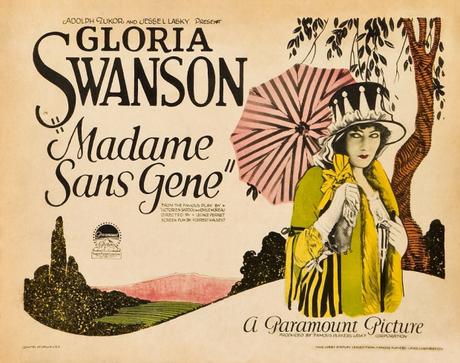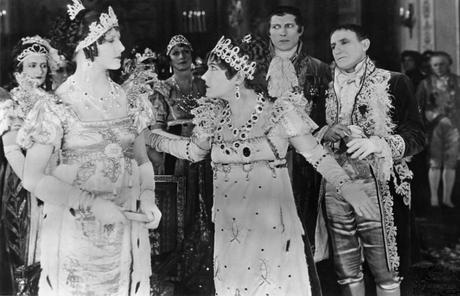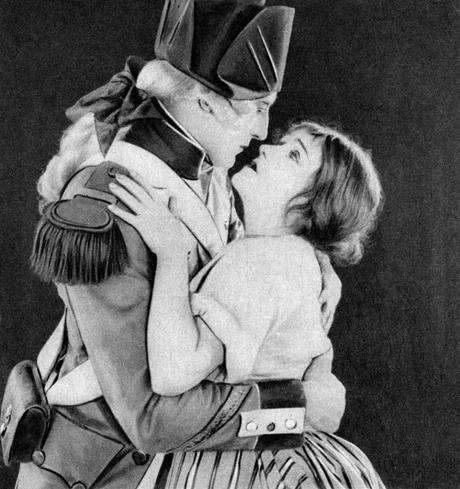
“Madame was the greatest star of them all.” While this line from 1950’s Sunset Boulevard is a reference to the character of Norma Desmond, it certainly also applies to the actress playing Norma Desmond: Gloria Swanson. Gloria wasn’t the first movie star to become an international celebrity, but she was unquestionably one of the biggest stars of the silent film era. Between Sunset Boulevard and her career working in silent films, she is forever tied to the public’s image of silent film stars. Out of all the box office hits she made during her career, none of them reflects how big of a star she was at the height of her fame like 1925’s Madame Sans-Gêne.
By 1925, Gloria had reached a tipping point in her career. Her work in Cecil B. DeMille costume dramas had made her a megastar years earlier, but as her costumes got more elaborate and her hairstyles got more complicated, she eventually got tired of her clothes horse image and decided to move on from DeMille to focus more on more character-driven projects. Breaking a successful formula is always a gamble, but it paid off for her in spades and movies like Zaza and Manhandled made her an even bigger star. But the weight of being such a big star was starting to become too much.
While she was working on 1924’s Her Love Story, she was also busy plotting her next career move. Her first choice was to star in Paramount’s adaptation of Peter Pan and was livid that it hadn’t already been offered to her. She was on the verge of heading to London so she could personally speak to J.M. Barrie and make her case for playing Peter Pan when she heard about a play by the name of Madame Sans-Gêne, which a friend thought she might be interested in getting the film rights to.
Madame Sans-Gêne was first described to Gloria as being about, “A washerwoman who is elevated to nobility by Napoleon.” Hardly an exciting summary, but it really is the most succinct way to put it. Gloria wasn’t impressed, but she trusted her friend’s judgment and asked him to read the play aloud to her. Despite the underwhelming summary, she loved the play and thought it was well-written and funny. As she and her friend discussed the project further, they agreed that such a beloved French story needed a French director and to be filmed on location in the same places Napoleon had actually lived.
With Peter Pan and Madame Sans-Gêne in mind, Gloria made arrangements to visit London and Paris so she could put her ideas into motion. Shortly after arriving in London, Gloria’s pursuit of Peter Pan came to an end when J.M. Barrie announced Betty Bronson was to play Peter Pan. Disappointed but not deterred, Gloria simply put all of her focus on Madame Sans-Gêne and headed on to Paris, where she was set to meet with film critic Andre Davin and Adolphe Osso, head of the European division of Paramount. Davin was very enthusiastic and supportive of her ideas for Madame Sans-Gêne, being particularly optimistic about her chances of being able to film on location. Osso, on the other hand, was considerably less confident. He thought an American would never be able to get the rights to such a distinctly French story and even if she did get that far, she would never be able to film on location, noting that Germany’s UFA studio had tried to get permission to film on those very same historic locations several times before without success.

Once Davin wrote a glowing article about Gloria’s plans for Madame Sans-Gêne, Osso was proven wrong — quite overwhelmingly — and Paramount quickly agreed to let Gloria have anything she wanted to make this movie happen. She got the French director she wanted, Leonce Perret, and permission to film on the locations she had her heart set on, including Fontainebleu and La Malmaison. To add some icing to the cake, she hired Henri de la Falaise, Marquis de la Coudraye to act as something of a chauffeur/translator/personal assistant. Although he had a title, Henri did not have much money but he had enough influence and connections to help the production continue running smoothly. Before long, he would also become Gloria’s third husband.
By the time Madame Sans-Gêne was set to premiere in the United States, there was enough drama surrounding it to merit its own movie. Shortly before she arrived in the States, she started suffering complications from an abortion she didn’t want to have and only did so because of the morality clause in her contract with Paramount. As she lay gravely ill in a Paris hospital, the media was hard at work keeping fans up to date about her condition. On top of it all, Paramount executives were putting pressure on her to recover quickly so she could travel to the United States and promote the movie. Even once she arrived in the States, she was still completely exhausted and just wanted to rest, but she carried on. Adding to the drama was the fact that she was no longer just Hollywood royalty, she had a real title. Her recent marriage had officially made her the Marquise de la Falaise de la Coudraye and her fans couldn’t wait to see her and her new husband.
Madame Sans-Gêne had its first gala premiere at the Trivoli Theater in New York City on April 17, 1925. Thousands of fans lined the streets, causing traffic problems. Those who spent $5 ($73.30 adjusted for inflation) for tickets to the big event had to be escorted into the theater by the police because of the huge crowds. Gloria and Henri invited the Grand Duke and Duchess of Russia to attend as their guests, but the police were so focused on protecting Gloria and Henri that the Grand Duke and Duchess were effectively left to fend for themselves and ended up entering the theater with torn and mussed clothing. The theater itself was decked out in French and American flags. The New York Times described the movie as being a secondary affair, as about half the theater was more interested in seeing Gloria in person. However, the New York premiere was a mere warm-up for the one that would come in Hollywood.
From New York, Gloria and her husband boarded a train for Chicago before heading on to Los Angeles, making stops along the way to greet adoring fans. Once she finally made her way to Los Angeles, the city pretty much shut down for her. Hollywood has certainly seen its share of major film-related events over the years, but the premiere of Madame Sans-Gêne and Gloria’s arrival for it makes the Oscars seem like a quiet, understated affair.
Two years had passed since Gloria was last in the state of California and a veritable who’s who of the film industry was waiting to greet her at the train station. Naturally, lots of big names from her home studio of Paramount were there to welcome her back, including Cecil B. DeMille and Rudolph Valentino. Since United Artists had been trying to convince her to join them, Charlie Chaplin, Mary Pickford, Douglas Fairbanks, and D.W. Griffith were all there. Bebe Daniels, Mack Sennett, Charley Chase, and Frank Borzage were just a few more of the familiar faces in the crowd that day. And, just for good measure, the Mayor of Los Angeles and two brass bands were also there. Hedda Hopper wrote that schools had been closed for the day. Edith Head recalled Paramount Studios being shut down so their employees could be part of it all. And, of course, there were more traffic jams as thousands more fans waited in the streets to see her.

Madame Sans-Gêne premiered in Los Angeles on April 24th at Grauman’s Million Dollar Theater and it was a night that Swanson would go on to call the most unforgettable night of her life. In several interviews, including her interview for Kevin Brownlow’s Hollywood documentary series, she recalled the incredible feeling of walking into the theater, having a spotlight directed onto her, and hearing the orchestra start playing “Home Sweet Home.” Colleen Moore was at the premiere and later said of that moment, “There was Gloria in a shimmering white gown coming down the aisle on the arm of her handsome, titled husband. They looked like the king and queen of some mythical Balklan kingdom.” Adela Rogers St. John said of the event, “I saw men standing on their seats, waving their arms, other women tearing off their orchids and flinging them into the aisle for Gloria Swanson to walk on — and I saw Mack Sennett frankly wiping the tears from his proud face.”
Once she made her way to her seat, she was right between Cecil B. DeMille and Mack Sennett. But once the movie began, the night was over for her. To avoid the crowd, she was ushered out the theater’s back exit. As she headed home with her entourage, Gloria was remarkably quiet. When asked what was wrong, she said, “I’m only twenty-six. What’s left? How can I top it?” On top of that, she was dealing with a lot of guilt over the abortion she’d had and was truly feeling like studio heads only saw her as a way to make money for themselves.
While the night was certainly unforgettable for Gloria, the movie itself was less noteworthy to critics. Critics generally had good notes about Gloria’s performance and the authentic French locations didn’t go unappreciated, but reviews were pretty mixed. In The New York Times, Mordaunt Hall wrote, “Aside from Miss Swanson’s performance and possibly that of the roles of Napoleon and La Rousette, the characterization that is obtainable on the stage is lacking on the screen. Somehow the players are pleasant but rather flat.” There were also criticisms of the story, which Gloria attributed to cuts Paramount made to the film. She didn’t care for those cuts, either, and an uncut version of the movie was released in France.
Despite the mixed reviews, Madame Sans-Gêne was a box office success. At the Trivoli Theater alone, it brought in $41,000 ($601,744.13 adjusted for inflation) in its first week, breaking the previous house record set by Blood and Sand with Rudolph Valentino. It played around the country to great success in a road show format, where attendees received a commemorative program and coin with Gloria’s face on it.
After Madame Sans-Gêne, Gloria still had four movies left on her contract at Paramount and it was time for her to seriously start thinking about the future again. United Artists eventually won out in convincing her to leave Paramount behind and become an independent artist for them. Not only did she like the prospect of having full creative control over her projects, she’d had enough of Paramount meddling in her personal life, and she didn’t want to risk becoming replaceable at Paramount. However, being an independent filmmaker proved to be more challenging than Gloria anticipated.
The United Artists era of Gloria Swanson’s career yielded some triumphs, but also some considerable setbacks. 1928’s Sadie Thompson and 1929’s The Trespasser were hits at the box office and her performances in both films earned Academy Award nominations. However, The Trespasser would be her last box office success until Sunset Boulevard was released over twenty years later. Her first film for United Artists, 1927’s The Love of Sunya, was a box office disappointment and in between Sadie Thompson and The Trespasser, she made the infamously disastrous Queen Kelly, which was never finished and went unseen for decades. As the 1930s progressed, her film appearances became less frequent. By the decade’s end, she had moved away from Hollywood and was focusing her attention on a company she’d created for the purpose of helping scientists and inventors escape from Nazi-occupied Europe.
Over the years, all known prints of Madame Sans-Gêne, both in its French and American versions, disappeared. In a 1970 appearance on The Dick Cavett Show, she made a remark about Madame Sans-Gêne being a lost film. In her autobiography Swanson on Swanson, Gloria had this to say about her lost films:
“…Many of my early pictures have been shown at film festivals around the world. Each time this happens, the same sad questions are always asked: Does anyone know of a print anywhere of Beyond the Rocks, the film Rudy Valentino made with me in 1921? Can anyone locate a print of Madame Sans-Gêne? Does anyone have a complete copy, including the last reel, of Sadie Thompson?
I would love to see them again and know they’re not lost forever. That, after all, was supposed to be the great virtue of pictures — that they would last forever.”
Swanson on Swanson was published in 1980 and, sadly, many of these same questions can still be asked today. A print of Beyond the Rocks was found in 2003, but the final reel of Sadie Thompson is still lost and the only glimpse we have of Madame Sans-Gêne is its trailer. Perhaps someday, Gloria will be proven right and the world will be able to see Madame Sans-Gêne once again. While many of her films still exist, the loss of Madame Sans-Gêne leaves a large hole in the filmography of one of the silent era’s greatest stars.
Advertisements